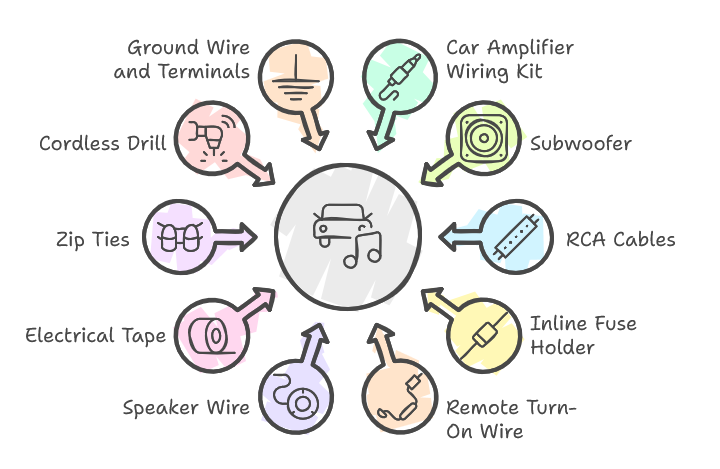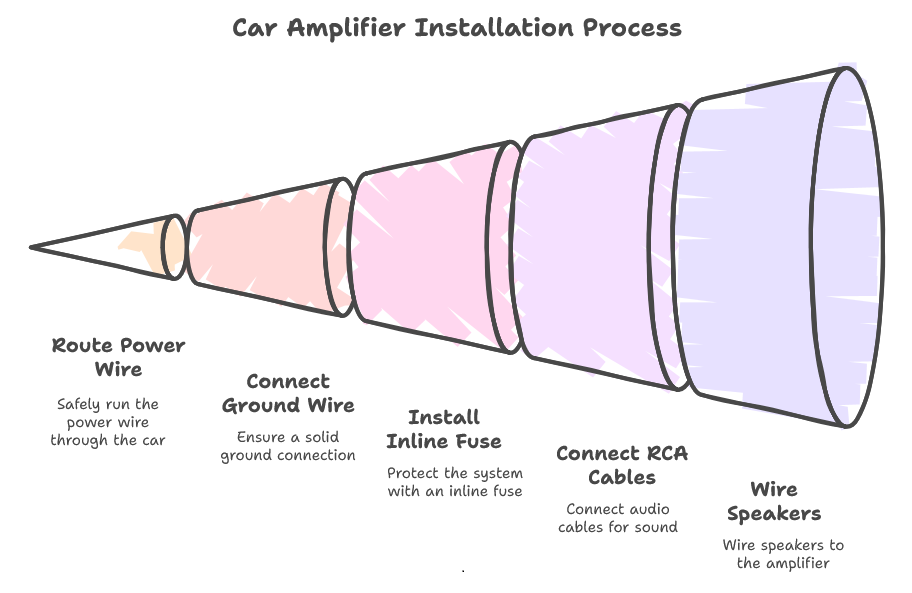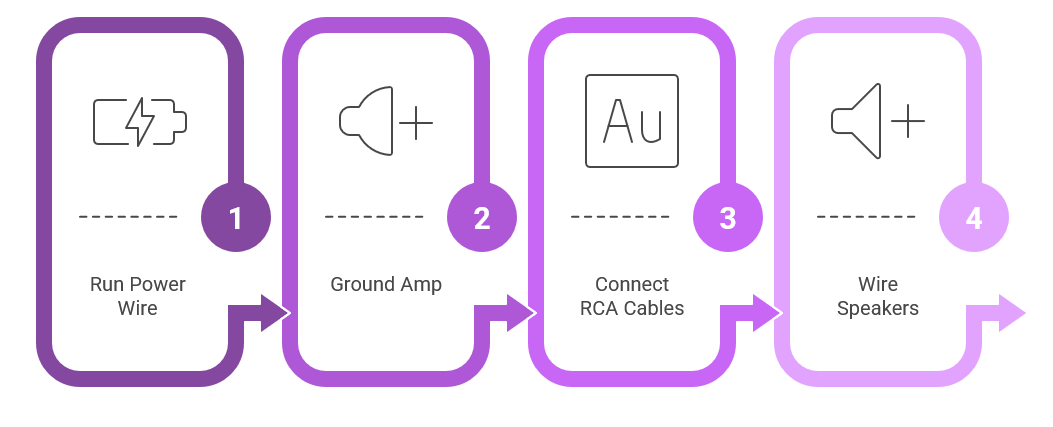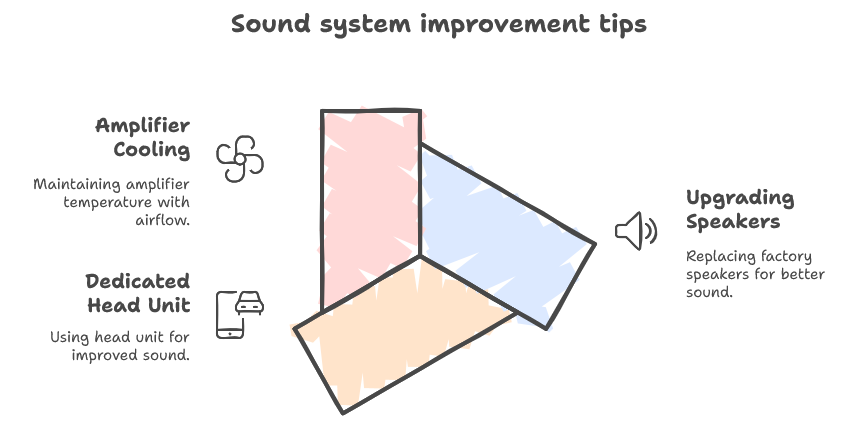This article was updated in April 29, 2025 with new products and information by Mark S. Taylor
There’s nothing like the first time you install a car amplifier and fire up that deep, rich bass—it’s pure magic. I still remember sitting in my driveway, grinning like a kid, feeling the whole car shake with my favorite track. If you’ve ever wondered how to install a car amplifier and a subwoofer the right way, you’re in the right place. Today, I’ll walk you through everything you need to know, from wiring tricks to smart troubleshooting, so you can build a system you’re proud of. Let’s dive in and get your ride sounding better than ever!
Contents
Why Install a Car Amplifier?
When I installed my first car amplifier, it felt like I had a whole new car. The music was louder, clearer, and the bass hit so hard it felt like a heartbeat. It was one of the best upgrades I ever made. If you want your music to sound full and alive, installing a car amplifier is the way to go.
An amp boosts sound quality big time. It gives your music more power and makes the bass deeper. Whether you have factory speakers or an upgraded stereo, adding an amp makes everything sound better. (Quick answer: A car amplifier makes your music louder, clearer, and full of deep bass.)
Many people install a car amplifier when they add a subwoofer. Stock systems can’t handle the power needed for deep bass. Others just want better clarity when they turn up the volume. An amp stops your music from sounding thin or fuzzy at high levels. (Quick answer: An amp is key for strong bass and clear sound even at high volume.)
Things you need
So as to do it right, there are things that you should get ready so as to set up the best amplifier for car. Some of the things that you will need include:
- Electrical connections which include a battery connection, a connection with the metal body of the car, an audio signal, as well as wiring required to connect the amp to the subwoofer.
- A subwoofer is also needed. This is a speaker which is clearly designed to produce a heavy bass. This should also have an enclosure to hold it. Most vehicles have a +12V connection and therefore it is very easy to find and use it. However, some of the modern cars do not have this since they use computerized signals.
- Time for planning is also required if you are to do the installation successfully. The best amplifier for car subwoofer takes considerable time to install properly. The installation depends on the kind of vehicle that you have. If the subwoofer is being added to a system that was factory set, then more work is expected. Take time to work during the day so as not to rush and do substandard work. When you are stressed, you are more likely to make errors and you may have to repeat all over again. Make sure you have the right tools when installing the best amplifier for car audio.
- There are parts that need to be gathered so as to start the installation. The first one is an amplifier wiring kit ready with a remote wire, fuse holder, and all the necessary accessories. Other things include hand tools, cordless drill, mounting braces, electrical tape, speaker wire, straight wire, self-tapping screws, and wire ties.
- Selecting the amp is another important step. Most modern apps possess the necessities that are basically needed so as to work with subwoofers so as to achieve best car amplifier for bass. Take a critical look at the features and then select wisely. You can go through reviews when you are making your selection. Check the speaker levels as well. It need not be overpriced. There are affordable brands available in the market today which work just as well.
Tools and Materials You’ll Need
Before you jump into the install, it’s a good idea to have everything ready. Trust me, nothing’s worse than being halfway through and realizing you’re missing one tiny part. When I did my first setup, I had to run back to the store twice! Here’s a full list to make sure you’re set from the start.
-
Car Amplifier Wiring Kit: This is your lifeline. A good car amplifier wiring kit gives you all the cables, connectors, and fuses you’ll need.
-
Subwoofer: You’ll need a subwoofer to really bring out the bass. Make sure it matches the amp you choose.
-
RCA Cables: These connect your stereo to the amplifier for clean sound without static.
-
Inline Fuse Holder: This is super important for safety. A good car amplifier fuse installation protects your system from electrical fires.
-
Remote Turn-On Wire: This tiny wire tells your amp when to power up with the stereo. It’s small but mighty!
-
Speaker Wire: You’ll need quality wire to connect the amp to your speakers and subwoofer.
-
Electrical Tape, Zip Ties, and a Cordless Drill: Tape for securing wires, zip ties for neatness, and a drill to mount your amp like a pro.
-
Ground Wire and Terminals: A solid ground is key to stop buzzing and protect your gear.
(Quick answer: You’ll need a car amplifier wiring kit, subwoofer, RCA cables, fuse holder, speaker wire, and basic tools for a clean and safe install.)
Planning Your Installation
Before you even pick up a wrench, it’s smart to plan your install. I learned this the hard way when I rushed into my first project and ended up redoing half of it. Every car is different, so take a little time to check your model and figure out the best way to fit everything in. Trust me, five minutes of planning now saves hours of frustration later.
When you install a car amplifier, it’s not a race. A good setup usually takes a few hours, maybe even a full afternoon if you’re adding a subwoofer too. Give yourself plenty of time, and don’t rush it. Working under pressure is like trying to bake a cake in half the time—it just ends up a mess!
Choosing the best location for car amplifier is a huge deal. You want a spot that’s easy to reach but still safe and out of the way. Some people tuck it under a seat, in the trunk, or behind the rear seats. Personally, I found the trunk was perfect—plenty of space, great airflow, and it stayed nice and hidden.
(Quick answer: The best location for a car amplifier is a spot with good airflow, easy access to wires, and protection from damage—like under a seat or in the trunk.)
Choosing the Right Amplifier for Your Car Subwoofer
Finding the right amp feels a lot like finding the right hat. It has to fit your system just right or everything feels off. Look for the wattage, the number of channels, and if it’s a Class D or Class AB. Class D amps are cooler and save power. Class AB amps sound great but can get warm after a while.
(Quick tip: If you want strong bass without a lot of heat, go with a Class D amplifier.)
You also need to pick between a 2-channel or a 4-channel amp. If you check a 2 channel amplifier wiring diagram, you’ll see it powers two speakers or one sub when bridged. A 4 channel amp wiring diagram shows it can run four speakers or two speakers plus a subwoofer. I started with a 2-channel but later wished I had a 4-channel to grow my setup!
If money is tight, don’t stress. Good brands like Boss Audio, Rockville, and Planet Audio make solid amps at a fair price. I had a Rockville amp once and loved the clean bass it gave me without draining my wallet.
Wiring and Installing Your Car Amplifier: Step-by-Step
Routing the Power Wire
Running the car audio amplifier power wire is where the real fun begins! Always start at the battery and work your way inside. Use grommets to protect the wire when passing through the firewall. If your car has factory holes, use them — it saves time and keeps things neat.
(Quick tip: Keeping the power wire safe from sharp edges stops problems before they start.)
Secure the wire along the sides under trim panels. Make sure it’s away from moving parts or hot areas like the exhaust. Taking your time here avoids a lot of future headaches.
Connecting the Ground Wire
A strong car amplifier ground wire is just as important as your power wire — maybe even more. Find a solid, clean spot on the car’s metal frame. Sand off any paint so the connection is bare metal to metal.
(Short answer: A clean ground makes your system stable and prevents weird noises or shutoffs.)
Keep your ground wire short and thick, just like the power wire. It’s the small stuff that makes a big difference.
Installing the Inline Fuse
Your car amplifier fuse installation is like adding a helmet before a bike ride — it’s all about protection. Mount the inline fuse holder within 18 inches of the battery. This stops fires if the wire ever gets damaged.
(Fast tip: Always connect the fuse holder first before running the power wire.)
Crimp or solder the fuse holder to the power wire. Then, snap in the right size fuse. Double-check everything before moving on!
Connecting the RCA Cables and Remote Wire
Now it’s time to bring the music to life. Plug the RCA cables car amplifier into your head unit’s outputs and run them toward the amp. If you have a factory radio with no RCA outputs, use a line output converter. It changes speaker signals into RCA signals.
(Quick fix: No RCA output? A converter lets you still connect your car amplifier to stock radio setups.)
Also, hook up the remote turn on wire car amplifier to a switched 12V source. This wire tells your amp when to wake up and when to sleep.
Wiring the Subwoofer and Speakers
This part feels like wiring a little symphony. Follow the diagrams closely. If you’re using a 2-channel amp or a 4-channel amp, remember to check how you wire the speakers. Series wiring raises the load, while parallel lowers it.
(Simple answer: Series wiring = safer for amps, parallel = louder but needs careful setup.)
Use thick speaker wire for subwoofers. For door speakers, normal 16-gauge wire is fine.
Want a quick guide? Here’s how to wire an amp to speakers without frying anything: match the amp’s output to the speaker’s impedance (ohms) and power rating.
Final Mounting and Powering On
You’re almost ready to blast some tunes! Bolt your amp down tight. A flying amp in a hard stop isn’t just scary — it’s dangerous.
Before you power on, double-check all wires. Set the car amplifier gain setting low at first. Play some music and slowly raise the gain until it sounds clean and strong — no buzzing or distortion.
(Helpful hint: Distortion ruins speakers fast. Set your gains carefully for the best sound.)
If something doesn’t work right away, breathe. Car audio amplifier troubleshooting usually comes down to a missed wire, a bad ground, or a fuse issue. Check step-by-step and you’ll find it.
Helpful Installation Diagrams
Car Amplifier Wiring Diagram Examples
When I installed my first car amplifier, I stared at a bunch of wires and thought, “Where do I even start?” If you’re feeling the same way, you’re not alone. Wiring a car amplifier looks harder than it is. Let’s break it down with simple diagrams.
Basic Amplifier Setup
If you’re adding one amp for a subwoofer, it’s easy. Here is the short answer: run a power wire from the battery to the amp. Ground the amp to clean metal. Connect RCA cables from your stereo to the amp. Wire the subwoofer to the amp’s outputs.
Simple Steps:
- Power wire from battery to amp (with fuse close to battery)
- Ground wire from amp to bare metal
- RCA cables from stereo to amp
- Subwoofer wired to amp
This setup is great for adding bass to a stock system.
4-Channel Amp Wiring to 4 Speakers
If you want a full upgrade, a 4-channel amp is perfect. I remember my first time hearing music through four new speakers—it was like a live show! Here’s the quick guide: connect RCA cables from your stereo to the amp. Run speaker wires from the amp to each speaker. Make sure you ground the amp well.
Quick Steps:
- RCA cables from stereo to amp inputs
- Power wire from battery to amp with fuse
- Ground wire to bare metal
- Speaker wires from amp to speakers
Tip: Label your speaker wires to make future fixes easy.
Mono Block Amp for Subwoofer
If you’re powering just a subwoofer, a mono block amp keeps it simple. I love mono amps because they send all power to one place. Your bass hits harder and wiring is much easier.
Simple Steps:
- Power wire with fuse from battery to amp
- Ground wire to bare metal
- RCA cable from stereo to amp
- Speaker wire from amp to subwoofer
Short answer: Mono amps are easy to install and perfect for bass fans.
Joining the wire to the battery and engine
This is often the toughest part of installing the best class amplifier for car audio. The tricky part is getting your wire to your battery. However, in most cases you will find a plug, a hole, a gap, or even a rubber wiring where you can create a hole using a screwdriver. Make sure you check below the dashboard so as to find any filler plug that you can push out. This helps you find a hole that is free for use. You can use the long wire that can act as a snake used to pull the wire through. This can be done using the normal wire coat hanger. This needs to be straightened out. Make sure the end is bent and rounded so as not to snap on other obstacles as you pull.
When dealing with a factory wiring harness seal, you will have to push all the way through so that you can grab the wire and pull it through the compartment.
The other steps include:
- Connecting the positive wire to the fuse holder
- Connect the ground wire the metal near the area where you intend to place the amplifier and woofer.
- Connect the remote to the stereo and the signal source
- Mounting the amplifier
- Power on so as to detect any problems that may be in the system
- Installation of the power fuse
There are many things that have to be learnt before you can successfully install the best amplifier for car audio but the results are worth the effort. There are many changes that you can make to the system so as to enhance the music experiences even more.
Troubleshooting Common Problems
Amp Won’t Power On
I remember the first time my amp stayed dead after wiring it up. I panicked, thinking I broke something. Most of the time, it’s a simple fix. The quick check: make sure your power wire has a good connection to the battery, the ground wire is tight on clean metal, and the fuse isn’t blown. Bad remote wires also leave the amp powerless.
Short answer: If your amp won’t power on, check the fuse, ground, power wire, and remote wire first.
Amp Goes Into Protection Mode
Seeing that little red light blinking “protection” made my heart sink the first time. Usually, it means the amp is getting too hot, wired wrong, or the speaker load is too low. The quick tip: let it cool, double-check wiring, and make sure your subs match the amp’s specs. Never just crank the gain to “fix” it—that’s a shortcut to blowing your gear.
Short answer: Protection mode means overheating, wiring mistakes, or speaker mismatch. Cool it down and recheck your setup.
No Sound from Subwoofer
It’s the worst feeling to fire up your system and hear… nothing. When this happened to me, it was a loose RCA cable. Sometimes it’s the amp settings too. Make sure your RCA cables are pushed in all the way. Check your subwoofer wiring. Also, look at the amp’s gain and crossover settings—sometimes they’re just turned down too low.
Short answer: No subwoofer sound? Check RCA connections, speaker wiring, and amp settings carefully.
Pro Tips for an Even Better Sound System
Upgrading Your Stock Speakers
Swapping out your factory speakers is one of the biggest upgrades you can feel right away. I still remember the first time I upgraded—the vocals sounded alive, and the bass hit way cleaner. If you want better sound, stock speakers just can’t keep up.
Quick tip: Upgrade your stock speakers with good quality aftermarket ones for clearer sound and stronger bass.
Using a Dedicated Head Unit with Android Auto or Apple CarPlay
Upgrading to a real head unit changed the way I used my car stereo. Having Android Auto or Apple CarPlay feels like having your phone built right into your dash. You get better sound quality too because these head units send a cleaner signal to your amp.
Quick tip: A dedicated head unit with Android Auto or Apple CarPlay improves sound and makes your ride smarter.
Keeping Your Amp Cool (Car Amplifier Heat Sink Info)
Heat kills amps faster than anything else. I learned the hard way one summer when my amp kept shutting down. Good airflow and proper mounting help a lot. Make sure your amp’s heat sink is not covered, and if you can, install a small fan near it.
Quick tip: Keep your amp cool by leaving space around the heat sink and adding airflow if needed.
FAQs About Installing a Car Amplifier
How do I connect car speakers to an amplifier?
Run speaker wires from the amp’s output terminals to each speaker. Match positive and negative connections.
Where should I ground my car amplifier?
Ground your amp to a clean, bare metal spot close to the amp. A good ground stops noise and helps the amp run better.
Do I need a fuse holder for my car amp?
Yes, you need a fuse holder near the battery. It protects your car and wiring from damage caused by shorts.
How to hook up an amp to factory speakers without RCA?
Use a line output converter. It changes speaker signals into RCA signals for the amp.
My Final Thoughts on Installing a Car Amplifier
If you’re someone who loves crisp sound and strong bass, installing a car amplifier is perfect for you. But if you feel unsure about handling wires and settings, it might be safer to ask a pro. Based on my experience, taking your time and double-checking every step saves you a lot of trouble. I had moments of doubt too, but the reward was worth it. If you have any cool installation stories, I’d love to hear them in the comments!




